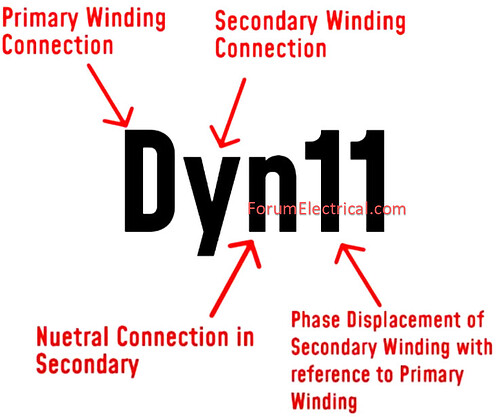What is Vector Group of a Transformer?
The vector group of a transformer displays the winding connection (Delta or Star) as well as the phase displacement (angle difference) across the primary and secondary voltage.
It is essentially a code (like Dyn11, Yd1 etc.) that states:
1). How the primary and secondary windings are connected (Star “Y” or Delta “D”).
2). Determine the phase shift (degrees) between primary and secondary voltages.
Why does Transformer have a Vector Group?
Transformers are always utilized in power systems, where numerous transformers can operate in parallel. If the phase difference (or) connection type is not appropriately matched, severe faults, circulating currents, and failures may occur.
Therefore, the vector group is defined as:
1). Maintain the right phase displacement to fulfill system requirements.
2). Safe parallel operation requires transformers with the same vector group.
3). System design: Some applications require a neutral point (Star connection for grounding), while others require a Delta connection to minimize third harmonics.
4). Fault handling: Use the correct vector group to control imbalanced loads and harmonics.
Why is Vector Group checked (tested)?
During transformer testing (particularly in manufacturing or commissioning on-site), the vector group test is performed to:
1). Confirm the manufacturer’s design is correct.
2). Ensure proper polarity & phase displacement.
3). Avoid mismatches while connecting a transformer to another in the grid.
4). Safety - An incorrect vector group results in an incorrect phase, which leads to a short circuit.
Examples of Vector Groups
Dyn11: Primary Delta, Secondary Star (Neutral available), 30° lead. Very common distribution.
Yd1: Primary Star, Secondary Delta, 30° Lag.
Delta on both sides with no phase shift (Dd0).
You can also follow us on AutomationForum.co, Facebook and Linkedin to receive daily Instrumentation updates.
You can also follow us on ForumElectrical.com , Facebook and Linkedin to receive daily Electrical updates.
